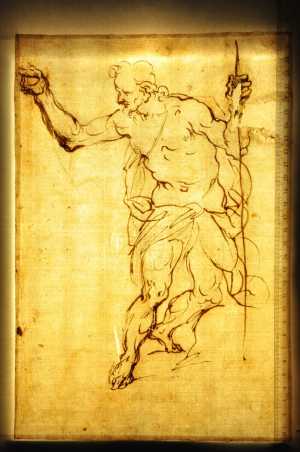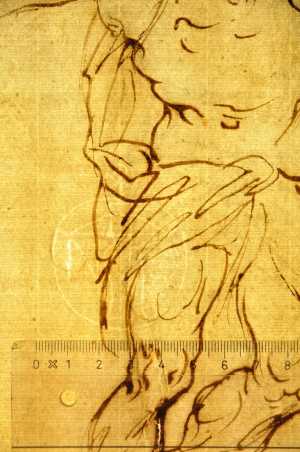Specifications
| Title | Study of St John the Baptist |
|---|---|
| Material and technique | Black chalk, pen and brown ink (irongall corrosion) |
| Object type |
Drawing
> Two-dimensional object
> Art object
|
| Location | This object is in storage |
| Dimensions |
Height 313 mm Width 214 mm |
|---|---|
| Artists |
Draughtsman:
Alessandro Maganza
Previously attributed: El Greco |
| Accession number | S 27 (PK) |
| Credits | Loan Stichting Museum Boijmans Van Beuningen (former Koenigs collection), 1940 |
| Department | Drawings & Prints |
| Acquisition date | 1940 |
| Creation date | in circa 1600-1610 |
| Watermark | Crossbow with initials N and O, in a circle, surmounted by a trefoil (53 x 43 mm, in the center, on P4 of 8P, vH, folio), similar to Briquet 764, 765, 768 (Ferrara 1580-93) and Piccard Online DE5580-Codgraec271_97/98 (Bavarian Ms., end 16th c.). [see image] |
| Inscriptions | ‘T[intorett]o’ (?, below left, pen in brown ink), 'Jacopo Tintoretto' (montuur, below right, pencil), ‘8m’ (montuur, centre, pencil) |
| Collector | Collector / Franz Koenigs |
| Mark | F.W. Koenigs (L.1023a on removed mount) |
| Provenance | Sir Archibald Alison (1792-1867), Glasgow (in an album); Art dealer Luigi Grassi (1858-1937, L.1171b), Florence (from the album, probably dismembered by him); Franz W. Koenigs (1881-1941, L.1023a), Haarlem, acquired in 1930 (attributed to El Greco); D.G. van Beuningen (1877-1955), Rotterdam, acquired with the Koenigs Collection in 1940 and donated to Stichting Museum Boijmans Van Beuningen |
| Research |
Show research Italian Drawings 1400-1600 |
| Literature | Tietze/Tietze-Conrat 1944, pp. 27, 292 under no. A 1754 and A 1757 (mid 17th-c.); Byam Shaw 1976, under no. 840; Paris 1996, under no. 61; Matarrese 2002, p. 67 n. 43 |
| Material | |
| Object | |
| Geographical origin | Italy > Southern Europe > Europe |
| Place of manufacture | Vicenza > Veneto region > Italy > Southern Europe > Europe |
Do you have corrections or additional information about this work? Please, send us a message

























